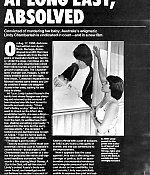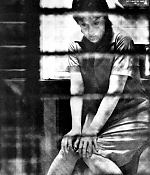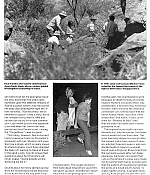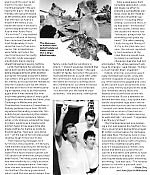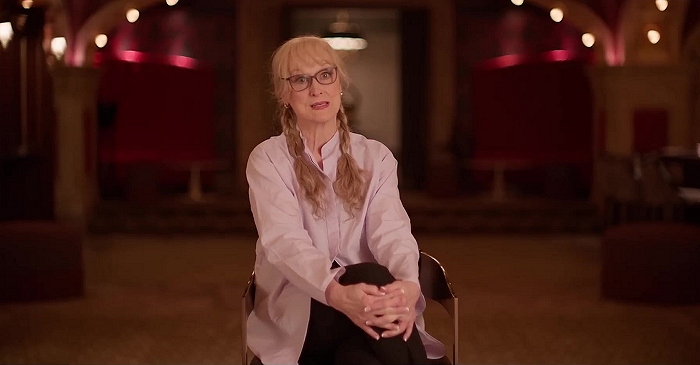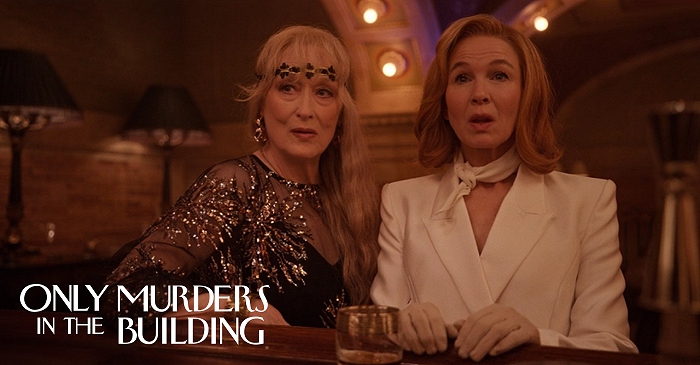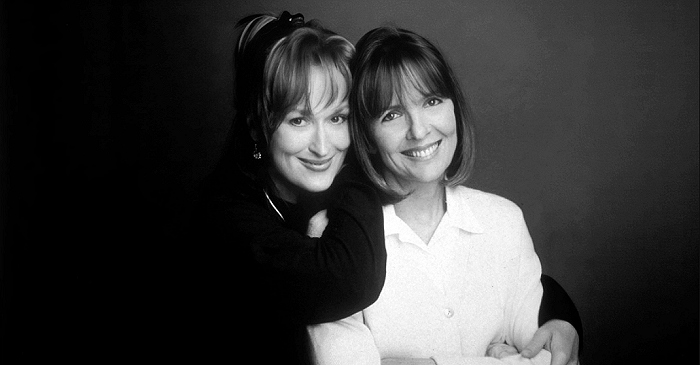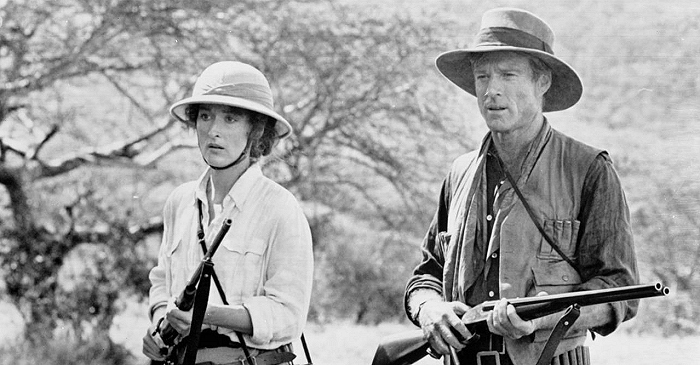|
Simply Streep is your premiere online resource on Meryl Streep's work on film, television and in the theatre - a career that has won her acclaim to be one of the world's greatest living actresses. Created in 1999, Simply Streep has built an extensive collection over the past 25 years to discover Miss Streep's body of work through thousands of photographs, articles and video clips. Enjoy your stay and check back soon.
|
|
At long last, absolved
People Magazine ·
October 24, 1988
· Written by Paula Chin, John Dunn
| ||
On Aug. 17, 1980, darkness had settled over Ayers Rock, the huge, dome-shaped monolith that rises majestically from the stark plains of Australia’s Northern Territory. Under the clear, moonless sky, Michael and Lindy Chamberlain joined their fellow tourists around the campground’s barbecues. The Chamberlains’ younger son, Reagan, 4, had already bedded down for the night. Now Aidan, 7, watched impatiently as Michael heated some beans and Lindy coddled 9-week-old daughter Azaria in her arms, waiting for the baby to sleep.
At 7 p.m. Lindy tucked Azaria in the family tent where Reagan was sleeping and returned to the cookout. A few minutes later Michael turned to his wife and said calmly, “I think that’s Bubby crying.” When Lindy went to check on the infant, she would later testify, she saw a dingo-an Australian wild dog—emerging from the tent, its wolf like head held low, shaking something vigorously. “I dashed into the tent, but the carry-cot was empty,” she recalled. “I looked around, but there was no sign of Azaria.” Then the horror sank in. “My God! My God!” Lindy shrieked. “The dingo’s got my baby!” That cry touched off the most controversial criminal case in Australia’s recent history—and plunged Lindy Chamberlain into the center of a drama that polarized the nation and captured headlines worldwide. Next month a film starring Meryl Streep, A Cry in the Dark, will tell the story of Lindy’s ordeal. Azaria’s body was never found, and investigators did not believe her mother’s account of the child’s disappearance. Citing stains found in the Chamberlains’ car, police accused Lindy of cutting Azaria’s throat with a pair of scissors. In 1982 a jury found Lindy guilty of murder, and she was sentenced to life imprisonment.
Now it appears that the case against Lindy was a shocking miscarriage of justice, built on questionable circumstantial evidence and a singular personal quirk that cast doubt on her credibility. Icy and remote, Lindy was peculiarly unable to express the grief and outrage one would expect of someone who is wrongly accused. Indeed, she might be languishing in prison still were it not for the aboriginal trackers who, more than five years later, stumbled upon the tattered remains of Azaria’s jacket, which Lindy had sworn her baby was wearing the night the infant vanished. That discovery, which seemed to support Lindy’s story, led to her release from prison in 1986 and spurred an inquiry by a royal commission. Last month justice was apparently served when her conviction was overturned by a Darwin court, closing the “Dingo Baby” case for good. That ruling, however, has not ended Lindy’s personal trials nor the public’s obsession with her. Skeptics still question how a dingo, which is rarely known to attack humans, could have dragged the baby off, leaving no trace of blood in the sand. Lindy, now 40, knows that questions about her innocence will never cease. “Some people will die believing we did it.”
Doubts about her story spread quickly from the moment journalists descended on Ayers Rock the day after Azaria’s disappearance. Many reporters were disturbed by the behavior of the Chamberlains: The couple declared their baby dead long before searchers had given up hope, and Michael reportedly tried to sell photographs of his family to an Adelaide newspaper. By the time of the initial inquest, four months later, the Chamberlains were besieged by death threats and bomb hoaxes. Rumors circulated that Lindy and Michael, a Seventh-Day Adventist minister, were linked to the infamous Jonestown cult. Others had it that the name Azaria meant “sacrifice in the wilderness” (the name, in fact, is Hebrew for “Blessed of God”) and that the baby had been slain in some gruesome ritual. The inquest found insufficient evidence to try Lindy for murder, but disbelievers would not rest their case. The most damning opinion to emerge after the inquest came from James Cameron, a British forensics expert, who conducted tests on Azaria’s jumpsuit, found near a dingo lair three miles from the campsite a week after her disappearance. Cameron concluded that cuts on the jumpsuit’s collar were made not by canine teeth but by scissors and that the pattern of bloodstains matched the prints of a small adult’s hands. To make matters worse, Australian biologist Joy Kuhl weighed in with the claim that stains in the Chamberlains’ car and on a pair of scissors they owned were of blood from an infant under 6 months old.
In September 1982 Lindy was brought to court to be tried for murder. Seven months pregnant (“We are hoping for a girl,” she told friends), she sat grim-faced as the prosecution charged that she had cut Azaria’s throat in the family’s car, hidden the body in Michael’s camera bag and later buried Azaria near Ayers Rock. “It’s not true!” Lindy sobbed in a rare outburst of feeling, then composed herself and tried desperately to convince the court of her innocence. Her protestations were futile, and when the court pronounced her guilty of murder, Lindy was again emotionally blank, staring straight ahead and saying nothing. Lindy maintained her strange reserve even as she suffered one devastating disappointment after another during her first year in Darwin’s Berrimah prison. She gave birth to a daughter, Kahlia, but could not win release to help her husband care for the infant. She was set free for five months pending an appeal, only to be imprisoned again after it was denied. But now doubt was growing about Lindy’s guilt. Supporters who formed the Save Lindy Campaign in Melbourne and the Chamberlain Innocence Committee in Sydney gathered more than 130,000 signatures demanding a new trial. Scientists began questioning the reliability of the forensic evidence. Meanwhile, Lindy stoically endured her days in prison, working as a cleaner and kitchen hand. In her spare time she made clothes for Kahiia or wrote to friends saying, “God and I are doing O.K.” On the wall of her cell was a sign reading Tough Times Don’t Last.
That reassuring message, as it turned out, was prophetic. In February 1986 trackers searching for the body of a British tourist who had fallen from Ayers Rock found Azaria’s jacket just 150 yards from where her jumpsuit had been found. The miraculous discovery lent new credibility to Lindy’s account of Azaria’s disappearance. Five days later she was released from prison by the Northern Territory government, which ruled that she would remain free regardless of the outcome of the royal commission inquiry. Even as she was reunited with her family, Lindy held her emotions in check. “I knew it would be realized that a mistake had been made,” she said matter-of-factly. And when the government pardoned her in June 1987, after the commission had concluded that the stains on Azaria’s clothing and in the Chamberlains’ car were not blood at all, Lindy still would not celebrate. “It is not over yet. We need to clear ourselves,” she declared, vowing that she would not rest until her murder conviction was overturned in court.
Only a step away from complete absolution, Lindy still made no effort to present a sympathetic persona, even to her most ardent and influential supporters—including Meryl Streep. Convinced that Lindy had been “mishandled” by the courts, Streep said she seized the movie role “because I always look for something that grabs my heart.” But after meeting Lindy during the filming of A Cry in the Dark late last year, the actress reportedly told members of the crew that she would have to project a coolness of character that she had not anticipated. “My whole approach will have to change,” said Streep. “[Lindy] is much harder than I imagined.”
Indeed, when her conviction was finally reversed last month, Lindy still seemed incapable of expressing her joy. While observers gasped and cried as the Darwin court declared her innocent, Lindy merely slumped in her seat. She remained stonily silent and flashed only a brief smile as she left the courthouse. But in a televised interview the next day, Lindy spoke with barely suppressed rage about the immeasurable injustice she had suffered. “I served just under three years in jail. I missed out on some of the most important things in life—Kahlia learning to walk and talk,” she said. “I regarded it as [the jury’s] fault.” The Chamberlains are now preparing a civil suit against the Northern Territory government, demanding at least $1 million compensation for damages and legal fees. The family lives in relative seclusion at a church compound in Cooranbong, 80 miles north of Sydney, where they resettled shortly after Azaria’s disappearance. While Lindy knows that there are some who still call her a murderer, she seems to have found a measure of peace. “I can live with it quite easily because I know they are wrong,” she has said. “The hardest person to live with is yourself, and I know I didn’t do it.”
Paula Chin and John Dunn in Melbourne


